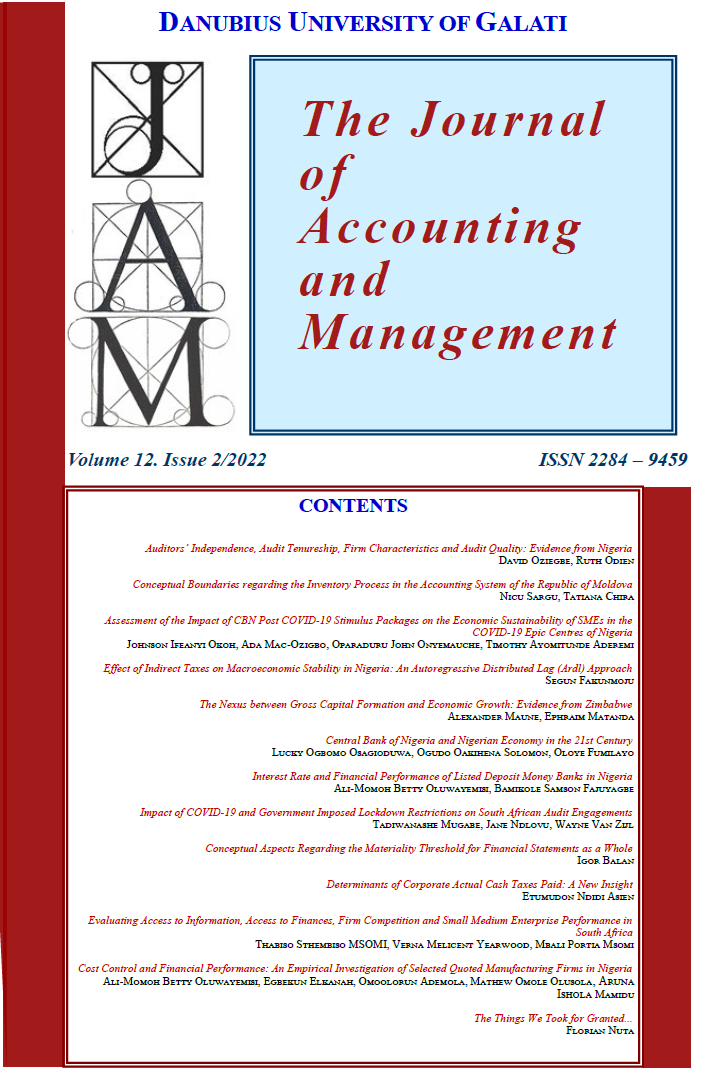The Nexus between Gross Capital Formation and Economic Growth: Evidence from Zimbabwe
Abstract
This article examined the nexus between gross capital formation and economic growth in Zimbabwe. Secondary data collected from World Bank`s World Development Indicators database, was used to empirically examine the nexus between the two variables, from 1960-2020. The autoregressive distributed lag technique was used. The findings show both unidirectional and bidirectional causality links between gross capital formation and economic growth during the three periods under study. Gross capital formation was positive, but not significant to influence economic growth in Zimbabwe. The period before dollarization was negative and significant to influence economic growth in Zimbabwe. The error correction had a negative and statistically significant relationship with economic growth in Zimbabwe. This article has practical implications especially for policy formulation and implementation at individual, corporate and government. The article closed the gap in knowledge by drawing attention to nexus of gross capital formation and economic growth in Zimbabwe during three different economic cycles.
References
Antelo, E. & Valverde, F. (1994). Determinant of private investment in Bolivia. Unidad de Análisis de Políticas Sociales y Económicas, 8, 1-30.
Attanasio, O., Picci, L. & Scorcu, A. (2000). Saving, Growth, and Investment: A Macroeconomics Analysis using a Panel of Countries. The Review of Economics and Statistics, 82(2), 182-211.
Bakare, A. S. (2011). A theoretical analysis of capital formation and growth in Nigeria. Far East Journal of Psychology and Business, 3(2), 11-24.
Bekhet, H. A. & Othman, N. S. (2011). Causality analysis among electricity consumption, consumer expenditure, gross domestic product (GDP) and foreign direct investment (FDI): Case study of Malaysia. Journal of Economics and International Finance, 3(4), 228-235.
Bond, S., Lebeblicioglu, A. & Schiantarelli, F. (2007). Capital accumulation and growth: A new look at the evidence. IZA Discussion, 1174. https://ideas.repec.org/a/jae/japmet/v25y2010i7p1073-1099.html.
Cheung, Y.W., Dooley, M. P. & Sushko, V. (2012). Investment and growth in rich and poor countries (No. w17788). National Bureau of Economic Research.
Karim, Z. A., Karim, B. A. & Zaidi, M. A. S. (2012). Fixed investment, household consumption, and economic growth: A structural vector error correction model (SVECM) study of Malaysia. International Journal of Business and Society, 13(1), 63-74.
Kumo, W. L. (2012). Infrastructure investment and economic growth in South Africa: A granger causality analysis. African development Bank Group Working Paper Series, (160). Retrieved from https://www.afdb.org/fileadmin/uploads/afdb/Documents/Publications.pdf. (Accessed 04/11/2022).
Levine, R. & Renelt, D. (1992) A sensitivity analysis of cross country growth regressions. American Economic Review, 82, 942- 963.
Meyer, D. F. & Sanusi, K. A. (2019). A causality analysis of the relationships between gross fixed capital formation, economic growth and employment in South Africa. Studia Universitatis Babeș-Bolyai Oeconomica, 64(1), 33-44. DOI: 10.2478/subboec-2019-0003.
Mordecki, G. & Ramírez, L. (2014). Investment, growth and employment: VECM for Uruguay. Serie Documentos de Trabajo/FCEA-IE; DT07/14.
Podrecca, E. & Carmeci, G. (2001). Fixed investment and economic growth: New results on causality. Applied Economics, 33, 177-182.
Rajni, P. (2013). Linkages between export, import and capital formation in India. International Research Journal of Social Sciences, 2(3), 16-19.
Rodrik, D. (2000). Saving Transitions. The World Bank Economic Review, 14(3), 481-507.
Shuaib, I. M. & Ndidi, N. D. E. (2015). Capital formation: Impact on the economic development of Nigeria 1960-2013. European Journal of Business, Economics and Accountancy, 3(3), 23-40.
World Bank`s (2022). World Development Indicators [Data file]. Washington DC: World Bank.
Downloads
Published
How to Cite
Issue
Section
License
Copyright (c) 2022 Alexander Maune, Ephraim Matanda

This work is licensed under a Creative Commons Attribution-NonCommercial 4.0 International License.
The author fully assumes the content originality and the holograph signature makes him responsible in case of trial.

